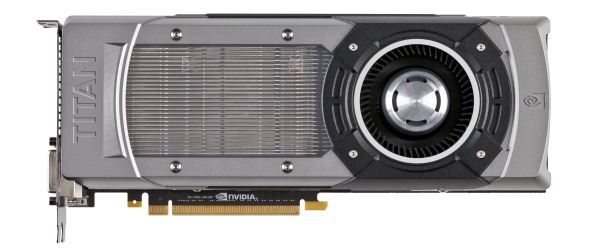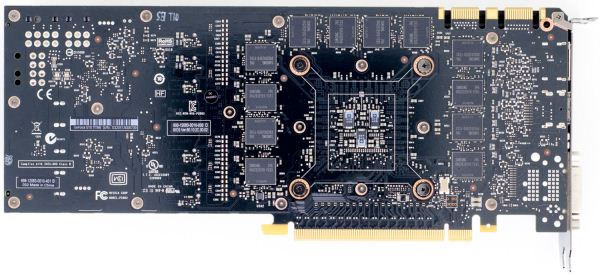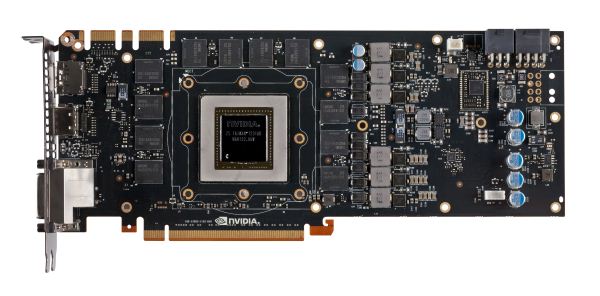NVIDIA's GeForce GTX Titan, Part 1: Titan For Gaming, Titan For Compute
by Ryan Smith on February 19, 2013 9:01 AM ESTMeet The GeForce GTX Titan
As we briefly mentioned at the beginning of this article, the GeForce GTX Titan takes a large number of cues from the GTX 690. Chief among these is that it’s a luxury card, and as such is built to similar standards as the GTX 690. Consequently, like the GTX 690, Titan is essentially in a league of its own when it comes to build quality.
Much like the GTX 690 was to the GTX 590, Titan is an evolution of the cooler found on the GTX 580. This means we’re looking at a card roughly 10.5” in length using a double-wide cooler. The basis of Titan’s cooler is a radial fan (blower) sitting towards the back of the card, with the GPU, RAM, and most of the power regulation circuitry in front of the fan. As a result the bulk of the hot air generated by Titan is blown forwards and out of the card. However it’s worth noting that unlike most other blowers technically the back side isn’t sealed, and while there is relatively little circuitry behind the fan, it would be incorrect to state that the card is fully exhausting. With that said, leaving the back side of the card open seems to be more about noise and aesthetics than it does heat management.
Like the GTX 580 but unlike the GTX 680, heat transfer is provided by a nickel tipped aluminum heatsink attached to the GPU via a vapor chamber. We typically only see vapor chambers on premium cards due to their greater costs, but also when space is at a premium. Meanwhile NVIDIA seems to be pushing the limits of heatsink size here, with the fins on Titan’s heatsink actually running beyond the base of the vapor chamber. Meanwhile providing the thermal interface between the GPU itself and the vapor chamber is a silk screened application of a high-end Shin-Etsu thermal compound; NVIDIA claims this compound offers over twice the performance of GTX 680’s grease, although of all of NVIDIA’s claims this is the least possible to validate.
Moving on, catching what the vapor chamber doesn’t cover is an aluminum baseplate that runs along the card, not only providing structural rigidity but also providing cooling for the VRMs and for the RAM on the front side of the card. Baseplates aren’t anything new for NVIDIA, but again this is something that we don’t see a lot of except on their more premium cards.
Capping off Titan we have its most visible luxury aspects. Like the GTX 690 before it, NVIDIA has replaced virtually every bit of plastic with metal for aesthetic/perceptual purposes. This time the entire shroud and fan housing is composed of casted aluminum, which NVIDIA tells us is easier to cast than the previous mix of aluminum and magnesium that the GTX 690 used. Meanwhile the polycarbonate window makes its return allowing you to see Titan’s heatsink solely for the sake of it.
As for the back side of the card, keeping with most of NVIDIA’s cards Titan runs with a bare back. The GDDR5 RAM chips don’t require any kind of additional cooling, and a metal backplate while making for a great feeling card, occupies precious space that would otherwise impede cooling in tight spaces.
Moving on, let’s talk about the electrical details of Titan’s design. Whereas GTX 680 was a 4+2 power phase design – 4 power phases for the GPU and 2 for the VRAM – Titan improves on this by moving to a 6+2 power phase design. I suspect the most hardcore of overclockers will be disappointed with Titan only having 6 phases for the GPU, but for most overclocking purposes this would seem to be enough.
Meanwhile for RAM it should come as no particular surprise that NVIDIA is once more using 6GHz RAM here. Specifically, NVIDIA is using 24 6GHz Samsung 2Gb modules here, totaling up to the 6GB of RAM we see on the card. 12 modules are on front with the other 12 modules on the rear. The overclocking headroom on 6GHz RAM seems to vary from chip to chip, so while Titan should have some memory overclocking headroom it’s hard to say just what the combination of luck and the wider 384bit memory bus will do.
Providing power for all of this is a pair of PCIe power sockets, a 6pin and an 8pin, for a combined total of 300W of capacity. With Titan only having a TDP of 250W in the first place, this leaves quite a bit of headroom before ever needing to run outside of the PCIe specification.
At the other end of Titan we can see that NVIDIA has once again gone back to their “standard” port configuration for the GeForce 600 series: two DL-DVI ports, one HDMI port, and one full-size DisplayPort. Like the rest of the 600 family, Titan can drive up to four displays so this configuration is a good match. Though I would still like to see two mini-DisplayPorts in the place of the full size DisplayPort, in order to tap the greater functionality DisplayPort offers though its port conversion mechanisms.














157 Comments
View All Comments
chizow - Friday, February 22, 2013 - link
Um, GF100/110 are absolutely the same league as this card. In the semiconductor industry, size = classification. This is not the first 500+mm^2 ASIC Nvidia has produced, the lineage is long and distinguished:G80, GT200, GT200b, GF100, GF110.
*NONE* of these GPUs cost $1K, only the 8800Ultra came anywhere close to it at $850. All of these GPUs offered similar features and performance relative to the competition and prevailing landscape. Hell, GT200 was even more impressive as it offered a 512-bit memory interface.
Increase in number of transistors is just Moore's law, that's just expected progress. If you don't know the material you're discussing please refrain from commenting, thank you.
CeriseCogburn - Sunday, February 24, 2013 - link
Wait a minute doofus, you said the memory cost the same, and it's cheap.You entirely disregarded the more than double the core transistor footprint, the R&D for it, the yield factor, the high build quality, and the new and extra top tier it resides in, not to mention it's awesome features the competition did not develop and does not have, AT ALL.
4 monitors out of the box, Single card 3d and surround, extra monitor for surfing, target frame rate, TXAA, no tesselation lag, and on and on.
Once a product breaks out far from the competitions underdeveloped and undeveloped failures, it EARNS a price tier.
You're living in the past, you're living with the fantasy of zero worldwide inflation, you'r living the lies you've told yourself and all of us about the last 3 top tier releases, all your arguments exposed in prior threads for the exaggerated lies they were and are, and the Charlie D RUMORS all you of the this same ilk repeat, even as you ignore the absolute time years long DEV time and entire lack of production capability with your tinfoil hat whine.
The market has changed you fool. There was a SEVERE SHORTAGE in the manufacturing space (negating your conspiracy theory entirely) and still there's pressure, and nVidia has developed a large range of added features the competition is entirely absent upon.
You didn't get the 680 for $350 (even though you still 100% believe Charlie D's lie filled rumor) and you're not getting this for your fantasy lie price either.
CeriseCogburn - Sunday, February 24, 2013 - link
NONE had the same or much bigger die sizes.NONE had 7.1 BILLION engineer traced research die points.
NONE had the potential downside low yield.
NONE had the twice plus expensive ram in multiples more attached.
NONE is the amount of truth you told.
Stuka87 - Tuesday, February 19, 2013 - link
Common sense would say nVidia is charging double what they should be.384bit memory is certainly not a reason for high cost as AMD uses it in the 79x0 series chips. A large die adds to cost, but the 580 had a big die as well (520mm2), so that cant be the whole reason for the high cost (the GK110 does have more transistors).
So it comes down to nVidia wanted to scalp customers.
As for your comments on AMD, what proof do you have that AMD has nothing else in the works? Not sure what crap you are referring too. I have had no issues with my AMD cards or their drivers (Or my nVidias for that matter). Just keep on hating for no reason.
AssBall - Tuesday, February 19, 2013 - link
You speak of common sense, but miss the point. When have you ever bought a consumer card for the pre-listed MSRP? These cards will sell to OEM's for compute and to enthusiasts via Nvidia's partners for much less.So it comes down to "derp Nvidia is a company that wants to make money derp".
Calling someone a hater for unrealistic reasons is much less of an offense than being generally an idiot.
TheJian - Wednesday, February 20, 2013 - link
A chip with 7.1B transistors is tougher to make correctly than 3B. Which card has 6GB of 6ghz memory from AMD that's $500 with this performance? 7990 is $900-1000 with 6GB and is poorly engineered compared to this (nearly double the watts, two slots more heat etc etc).This is why K20 costs $2500. They get far few of these perfect than much simpler chips. Also as said before, engineering these are not free. AMD charges less you say? Their bottom line for last year shows it too...1.18B loss. That's why AMD will have no answer until the end of the year. They can't afford to engineer an answer now. They just laid of 30% of their workforce because they couldn't afford them. NV hired 800 people last year for new projects. You do that with profits, not losses. You quit giving away free games or go out of business.
Let me know when AMD turns a profit for a year. I guess you won't be happy until AMD is out of business. I think you're hating on NV for no reason. If they were anywhere near scalping customers they should have record PROFITS but they don't. Without Intel's lawsuit money (300mil a year) they'd be making ~1/2 of what they did in 2007. You do understand a company has to make money to stay in business correct?
If NV charged 1/2 the price for this they would be losing probably a few hundred on each one rather than probably a $200 profit or so.
K20 is basically the same card for $2500. You're lucky their pricing it at $1000 for what you're getting. Amazon paid $2000ea for 10000 of these as K20's. You think they feel robbed? So by your logic, they got scalped 20,000 times since they paid double the asking here with 10000 of them?...ROFL. OK.
What it comes down to is NV knows how to run a business, while AMD knows how to run one into the ground. AMD needs to stop listening to people like you and start acting like NV or they will die.
AMD killed themselves the day they paid 3x the price they should have for ATI. Thank Hector Ruiz for that. He helped to ruin Motorola too if memory serves...LOL. I love AMD, love their stuff, but they run their business like idiots. Kind of like Obama runs the country. AMD is running a welfare business (should charge more, and overpays for stuff they shouldn't even buy), obama runs a welfare country, and pays for crap like solyndra etc he shouldn't (with our money!). Both lead to credit downgrades and bankruptcy. You can't spend your way out of a visa bill. But both AMD and Obama think you can. You have to PAY IT OFF. Like NV, no debt. Spend what you HAVE, not what you have to charge.
Another example. IMG.L, just paid triple what they should have for the scrap of MIPS. I think this will be their downfall. They borrowed 22million to pay 100mil bid for mips. It was worth 30mil. This will prove to be Imaginations downfall. That along with having chip sales up 90% but not charging enough to apple for them. They only made 30mil for 6 MONTHS! Their chip powers all of apples phones and tablets graphics! They have a hector ruiz type running their company too I guess. Hope they fire him before he turns them into AMD. Until Tegra4 they have the best gpu on a soc in the market. But they make 1/10 of what NV does. Hmmm...Wrong pricing? Apple pockets 140Bil over the life of ipad/iphone...But IMG.L had to borrow 22mil just to buy a 100mil company? They need to pull a samsung and raise prices 20% on apple. NV bought icera with 325mil cash...Still has 3.74B in the bank (which btw is really only up from 2007 because of Intel's 300mil/yr, not overcharging you).
CeriseCogburn - Sunday, February 24, 2013 - link
Appreciate it. Keep up the good work, as in telling the basic facts called the truth to the dysfunctional drones.no physx
no cuda
no frame rate target (this is freaking AWESOME, thanks nVidia)
no "cool n quiet" on the fly GPU heat n power optimizing max fps
no TXAA
no same game day release drivers
EPIC FAIL on dual cards, yes even today for amd
" While it suffers from the requirement to have proper game-specific SLI profiles for optimum scaling, NVIDIA has done a very good job here in the past, and out of the 19 games in our test suite, SLI only fails in F1 2012. Compare that to 6 out of 19 failed titles with AMD CrossFire."
http://www.techpowerup.com/reviews/NVIDIA/GeForce_...
nVidia 18 of 19, 90%+ GRADE AAAAAAAAAA
amd 13 of 19 < 70% grade DDDDDDDDDD
Iketh - Tuesday, February 19, 2013 - link
please drag yourself into the street and stone yourselfCeriseCogburn - Sunday, February 24, 2013 - link
LOL awww, now that wasn't very nice... May I assume you aren't in the USA and instead in some 3rd world hole with some 3rd world currency and economy where you can't pitch up a few bucks because there's no welfare available ? Thus your angry hate filled death wish ?MrSpadge - Tuesday, February 19, 2013 - link
Don't worry.. price will drop if they're actually in a hurry to sell them.